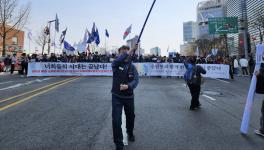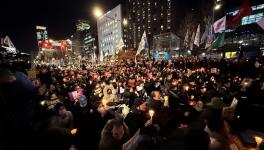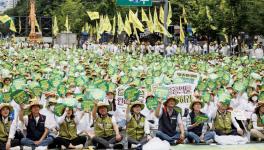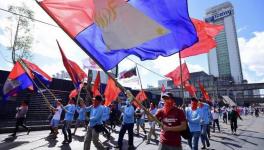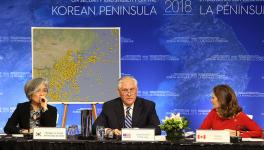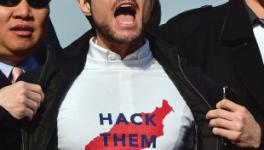Can South Korea’s New President Stand up to US?
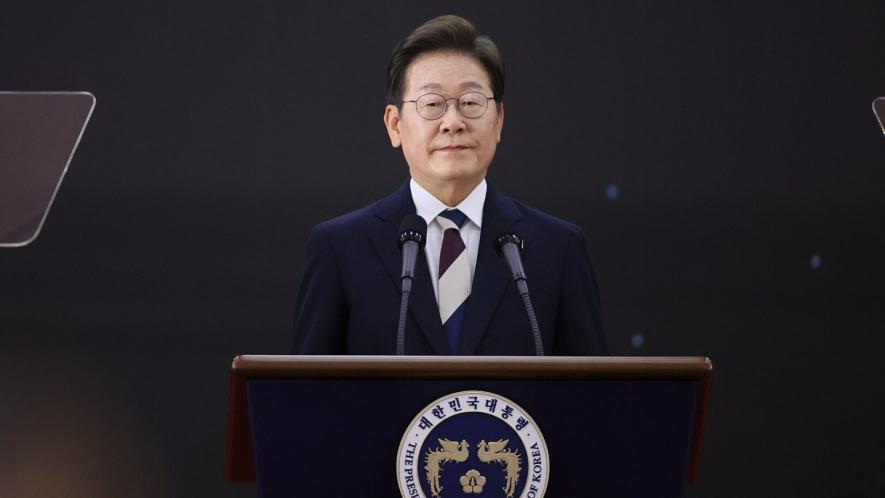
President of Republic of Korea Lee Jae-Myung at his first press conference as president in 2025. Photo: Wikimedia Commons
On June 3, the Republic of Korea (ROK) held a snap election to fill the vacant office of the presidency following the ouster of Yoon Suk-Yeol, who was impeached after his failed coup attempt on December 3, 2024. Lee Jae Myung, leader of the opposition Democratic Party (DP) and Yoon’s former rival in the 2022 election, emerged victorious with 49% of the vote, and was sworn into office on June 4.
As president, Lee now faces the challenge of navigating the economic, political, and geostrategic dimensions of the ROK’s generalized crisis. Unrelenting US aggression has pushed tension on the peninsula and the wider region to a breaking point. Simultaneously, the ROK faces a dire economic crisis that is certain to intensify as the Trump administration aims its “tariff bomb” at Seoul. Lee must effectively provide answers to these dilemmas while facing the reality of a deeply polarized population.
Korea in the snare of the New Cold War
The challenges facing the ROK are inseparable from the Korean Peninsula’s place in the US “Indo-Pacific” empire. While politicians in Washington and Seoul routinely harken to the “bond” between nations “forged in blood,” US General Xavier Brunson offered a more honest view in a recent keynote address. Brunson – who leads the three US-controlled military commands in Korea: US Forces Korea [USFK], Combined Forces Command [CFC], and the UN Command [UNC] – remarked, “What immediately stood out to me as I looked at the map was the position of the Korean Peninsula … it’s on the Asian continent, has a sizable US force posture, is inside the first island chain, and is the closest allied presence to Beijing.” Brunson continued, “At night, from a satellite image, [South Korea] looks like an island or like a fixed aircraft carrier floating … between Japan and mainland China. In freedom’s front yard.”
Under the New Cold War, Washington has made the Indo-Pacific – “freedom’s front yard” – its primary strategic priority, with Korea as a key focal point in this vast front. Consequently, US militarization of Korea has escalated alongside Washington’s growing belligerence against China. From 2007 to 2018, the US expanded Camp Humphreys in the city of Pyeongtaek, some 60 km south of Seoul, into its “largest power projection platform in the Pacific,” swallowing a behemoth 1,416 hectares. Beyond expanding existing bases and installing key strategic assets like the Terminal High Altitude Aerial Defense (THAAD) system, US-led war drills have sharply increased in frequency and intensity. In 2024, the US conducted a record 275 days of war drills in Korea – and will likely exceed this record this year. The devastating bombing of civilians in the village of Nogok-ri near the DMZ this March was a horrific reminder of the human toll military infrastructure and drills exact on the working people of South Korea, including its migrant workers.
Yet US ambitions for Korea also extend much further. The recently formed Japan-South Korea-US trilateral security cooperation (JAKUS) has roped the ROK into Washington’s “Asian NATO” agenda. Beyond JAKUS, the ROK Navy and Air Force have become routine participants in US-led war games throughout the region, from Gold Cobra in Thailand to RIMPAC in Hawai’i. The ROK’s considerable industrial capacity, from microchips to aerospace, shipbuilding, and space technology, have also been mobilized in service of Washington’s designs. US-ROK Space Force collaboration is among the closest of any military space partnerships in the world; South Korea became the first country to host an overseas US Space Force unit in 2022, and the two countries are engaged in a series of command and control drills known as Polaris Hammer which will extend throughout this year. Moreover, since the Moon Jae-In administration, the ROK now aspires to become a top four global weapons exporter; new contracts have already been inked this year with Canada and the US, and Lee Jae Myung has vowed to uphold this objective.
These escalations have catalyzed a new phase of Korea’s 80-year crisis of division and imperialist war. For the first time in its history, the DPRK officially abandoned its longstanding strategy of peaceful reunification in 2024, declaring the ROK a hostile state. The DPRK’s decision reflected a sober assessment of reality: that the New Cold War has brought tensions in Korea to their highest point since the signing of the 1953 armistice, and the ROK’s lack of political independence makes it an unreliable partner. President Yoon’s attempts to trigger a “limited war” with the DPRK just before and during his failed coup demonstrated the prescience of the DPRK’s maneuver.
War hawks denounce “pragmatic diplomacy”; Washington insists South Korea pick sides
So how does Lee’s agenda for the Korean Peninsula and the ROK’s foreign affairs address the ongoing crisis? While Lee’s approach to the DPRK and China are considerably different from Yoon’s, he has yet to lay out an agenda that would effectively challenge Washington’s vision for the region or the ROK’s place in the New Cold War. Lee’s platform of “pragmatic diplomacy” emphasizes balanced relations with Washington and Beijing on the basis of national interests, and he has even gone as far to declare that the ROK should have nothing to do with a potential Taiwan Strait conflict. Furthermore, he has vowed to revive efforts at dialogue with the DPRK, appointing a number of veterans of previous peaceful reunification talks to key cabinet positions.
These developments, however positive, will not be enough on their own to keep the ROK out of a US-China war or to reconcile with the DPRK. The New Cold War is not a static factor that can be brushed aside. Calls are growing in Washington to redefine USFK’s role and enable its 28,500 soldiers and considerable aerial assets in Korea to be deployed against China in the event of war. Pyongyang’s willingness to engage Seoul’s overtures will depend on the latter’s ability to demonstrate independence from Washington, which itself has just proven it is an untrustworthy diplomatic partner by greenlighting the Israeli attack on Iran in the midst of negotiations with that country.
Lee must confront the contradiction between remaining entangled in the network of US alliances, including JAKUS, and establishing a positive relationship with China and the DPRK. Credit ought to be given where it is due – Lee has shut off loudspeaker broadcasts at the DMZ which have been blaring nonstop for nearly a year, prompting the DPRK to shut off its own broadcasts as a reciprocal measure. Lee also declined an invitation to attend a NATO meeting in the Netherlands this past weekend, citing domestic priorities and “uncertainties due to developments in the Middle East.” These measures are positive, but Lee must act far more aggressively to distinguish his agenda from Washington’s. Seoul will never be seen as a trustworthy actor by Pyongyang and Beijing until its relationship with the US is totally redefined. Thus far, Lee has yet to indicate intentions to rock the boat.
This has not stopped the White House and the wider Trump movement from bristling at Lee’s election. In an emailed response to Reuters, an unnamed White House official stated, “While South Korea had a free and fair election, the United States remains concerned and opposed to Chinese interference and influence in democracies around the world.” Former Trump chief strategist Steve Bannon pulled no punches, lambasting Lee’s approach towards a balanced relationship with Beijing and Washington as “full of shit,” adding, “it’s tragic that a left-wing party beholden to the Chinese Communist Party has taken power in such a key partner country. We will not stay silent.”
Indeed, the greatest political challenge Lee will face will undoubtedly be the US. The extreme right of the ROK and the US enjoy a deep, organic alliance, and are moving in tandem to promote a shared agenda to redbait pro-democracy forces, maintain hostility towards the DPRK and China, and even redeploy US nuclear weapons to the peninsula. Both the Senate Armed Services and the Foreign Relations Committees are now chaired by advocates of redeploying US nuclear strategic assets to Korea. Underlying this is the brute logic of hegemonic US interests in Korea in the New Cold War. A recent report from the Atlantic Council put it bluntly, identifying the DPRK and China as a dual nuclear threat that Washington and its allies must prepare to combat simultaneously. Ominously, the paper even called for the US to endure nuclear strikes on its own territory as part of the price to be paid for victory.
Trump’s “tariff bomb” will be Lee’s first test
As thorny as the geopolitical situation in Korea has become, present economic realities pose the most immediate challenge. A recent study from the Korea Development Institute, a state-run think tank, projected a dismal 0.8% growth prediction for the ROK’s economy in 2025, less than half of last year’s 2.0% growth rate. The jobs predictions are even bleaker; with a workforce of nearly 30 million people, the ROK is only expected to produce 90,000 new jobs in 2025, and 70,000 new jobs in 2026. According to the Korea Institute for Industrial Economics and Trade, 8 of the ROK’s 13 core industries will face continued export decline in the second half of the year, with automobiles, oil refining, batteries, and general machinery taking hits close to 10%. This year, the value of the ROK won fell to its lowest point since the 2008 crisis. The US-Israeli war on Iran will inevitably hit the oil refining and petrochemical industries harder while driving up gas prices and further depreciating the won.
In truth, the ROK’s present economic contraction is only the latest spasm in a long crisis that can be traced back to the 1997 IMF Crisis. Since then, South Korea’s working class has been trapped in an unrelenting storm of economic pain. IMF structural adjustment undercut the gains of previous decades of labor struggle by pushing half the workforce into irregularized jobs that are not protected by labor laws. A decade later, the Korea-US Free Trade Agreement, now being undone by Trump’s tariff war, vastly expanded the reach and power of US-dominated multinationals and hollowed out the ROK’s agricultural sector. Even before the latest economic shocks, the ROK was facing record levels of household and personal debt, and a protracted crisis of youth unemployment and elder poverty. Out of OECD countries, South Korea ranks among the highest for workplace deaths and accidents, working hours, and unpaid domestic labor for women.
Lee has pledged to expand labor protections and slash work hours, including through the implementation of a 4.5-day work week, one promise he has already taken steps to deliver. These positions are popular, but improvements in working conditions alone will not extricate South Korea from its current crisis. The rise of new manufacturing hubs in China and now ASEAN have blunted the country’s competitive edge. As the export-oriented model of the 20th century falters, domestic demand is also proving inadequate.
Lee wants to wield the state purse to oversee a structural transformation of South Korea’s economy. The first order of business is a 30.5 trillion won (USD 22.15 billion) supplemental budget package that includes a $20.2 trillion won stimulus with cash handouts for citizens in the form of consumer vouchers valued between 150,000 to 400,000 won (USD 108 to USD 288). Beyond short-term efforts to boost domestic demand, Lee’s longer-term vision entails sustaining the ROK’s growing competitiveness in the weapons market, and making a play for a leading global position in AI through a massive 100 trillion won (USD 735 billion) investment. ROK conglomerate SK Group has already announced a joint venture with Amazon Web Services to build the country’s largest data center in Ulsan. Observers are also speculating that the president’s first policy chief, Kim Yong-beom, could push forward proposals to implement a “digital banco” international cryptocurrency system to supplant the dollar as the global reserve currency.
Lee’s attempts to address the structural challenges of South Korea’s economic position hold some merit, particularly in relation to his efforts to establish leadership in emerging technologies. The philosophy of the president’s AI policy chief, Ha Jung-woo, is especially noteworthy; Ha has consistently called for the ROK to develop “sovereign AI” tailored to Korean culture and history based on independent control of data. How this “sovereign AI” will be realized in partnership with Amazon Web Services, however, is yet to be demonstrated. Moreover, Lee’s vision could flounder in a matter of weeks if he cannot face the first great test of his administration: tariff negotiations with the US. South Korea’s rise from economic backwardness to an advanced, yet still dependent, capitalism was fueled by US Cold War geopolitical imperatives and capital’s need for cheap labor and investment outlets in the crisis of the 70s. Now, the strategic realities of the New Cold War are driving Washington to devour the economies of its vassals in a Saturn-like frenzy.
Washington’s deliberate economic strategy to cannibalize the industrial capacity of its clients crystallized under Biden. In a bid to retain control of supply chains in strategic technologies like microchips and electric vehicles, the Biden administration targeted the ROK with tariff threats that could only be avoided by relocating production to the US. ROK conglomerates swiftly followed suit: in 2024, Samsung opened a USD 17 billion chip plant in Taylor, Texas; in March, Hyundai opened a USD 7.5 billion electric vehicle plant near Savannah, Georgia. These measures successfully knocked China out of its previous position as the ROK’s top trade partner, and put many of the ROK’s dominant industries in jeopardy.
Trump’s trade war is now twisting the knife. The ROK faces a 25% “reciprocal” tariff (suspended until July 8) in addition to industry-specific tariffs on its key exports: 25% on cars, aluminum, and steel (the tariffs on these metals rose to 50% on June 4). This “tariff bomb,” as South Korean media has termed it, poses a mortal threat to the ROK’s export-dependent model. US-bound exports dropped 14.3% in April from USD 7.2 billion to USD 6.6 billion; in May, total year-on-year exports slipped for the first time in four months. While China is undoubtedly the primary target of the tariff bomb, South Korea is likely to be the most vulnerable of the Northeast Asian industrial economies. This is far from mere collateral damage; Trump has made no secret that South Korea is high on his list of allies who he sees as having “taken advantage” of free trade with the US. How the ROK’s fortunes fair from here will depend on the outcome of imminent negotiations between Washington and Seoul.
South Korean chaebol, the 45 conglomerates that dominate the economy, are scrambling to protect their access to the US market by pledging even greater investments in US manufacturing. Even before the tariffs were announced in April, Hyundai Motor Group unveiled plans to invest an additional USD 21 billion in the US over the next four years, which they claim will create 560,000 US jobs. Other Korean conglomerates will likely follow suit. It remains to be seen if new investment in the US will directly translate to job creation for US citizens as Trump has promised, but there is a clear connection between industrial flight to the US and South Korea’s meager job creation forecasts. Trump, meanwhile, is unlikely to be satisfied by these preemptive moves, and will probably seek to press the advantage in negotiations to secure more concessions diverting ROK investment to the US. Lee’s agenda to expand labor protections, cut work hours, and bring South Korea into the lead in the global AI race is likely to be a target of Washington’s pressure. Even the ROK’s weapons industry’s prioritization of native technology is a target.
Trump is also leveraging tariffs to advance the US military agenda in Korea. Trump has stated that he wants to renegotiate the US-ROK Special Measures Agreement, a cost-sharing deal to cover USFK expenses, to compel South Korea to pay annual tributes of up to USD 10 billion a year. Less outwardly, Washington is also likely to seek Seoul’s acquiescence to redefining USFK’s mission to enable smoother deployment from the peninsula to the Taiwan Strait or other Indo-Pacific flashpoints, effectively nullifying Lee’s pledge to remain neutral. Discussions on South Korea’s participation in the Golden Dome project could also take place. Ultimately, Trump’s use of US soldiers as a bargaining chip is a bluff – the US will not abandon its “aircraft carrier” in Korea. However, the threat of withdrawal, or even a superficial reduction in troop presence, poses a political problem for Lee, who risks attacks from the right and a loss of moderate support if he is perceived to have damaged security interests. A recent Pentagon leak alleging plans to relocate 4,500 troops from Korea to Guam reported by the Wall Street Journal in May, just weeks before the ROK snap election, must be assessed in light of these dynamics – this was likely a ploy to assert pressure on Seoul to capitulate to US demands.
Trump’s tariff maneuvers may prove a risky gambit – if Lee, and more importantly, the ROK’s organized workers and forces of the left, can effectively counter US pressure and build support for a redefined relationship with Washington. Even if the US agrees to significant tariff reductions, this will come at immense political and economic costs for the ROK that will hit its workers hardest. In order to preserve his mandate and advance the progressive elements of his agenda, Lee must be willing to stand up to the US and place the blame for the ROK’s economic pain on Washington, using Trump’s tariff rampage to pivot South Korea towards a more independent path. If he fails to do so, Lee risks repeating the errors of his predecessor, Moon Jae-In, who also rose to power on the back of a mass movement against the extreme right, only to pave the way for a conservative resurgence by failing to sufficiently contest the ravages of neoliberalism on the working class, or stand up to Washington’s meddling in the inter-Korean peace process.
Can Lee stand up to Washington?
Lee, and all South Koreans, would do well to remember that Trump’s narrative of South Korea as a free rider is baseless. In fact, the opposite is true – it is the US that has extracted tremendous profits and geopolitical advantages from the blood and sweat of the Korean people. The IMF Crisis and the Korea-US FTA in particular opened the floodgates for foreign capital, primarily from the US and Japan, to seize South Korean assets at firesale prices. South Korean workers have toiled in long hours under brutal conditions for more than half a century to provision the US with cheap commodities. The privilege of living in a US “aircraft carrier” also comes at a price. Environmental pollution is rampant throughout current and former US base sites, and Washington has always left the ROK to foot the bill. The aforementioned expansion of Camp Humphreys into the largest US base in the region was paid for with USD 11 billion in ROK public monies, and required the expropriation of rich agricultural land from thousands of local farmers. Beyond these steep costs, residents near the 62 US bases and facilities in Korea must also live with the realities of military crime and accidents. The incident at Pocheon earlier this year was a stark example, but a Ministry of Justice report in May also found a 70% increase in crimes committed by US soldiers from 2018 to 2023 – the majority of which went officially unsolved due to legal barriers preventing the investigation and prosecution of US troops by Korean authorities.
If Lee can stand up to Washington, the fanfare surrounding his election may prove merited. Should he fall short, it will be his detractors on the left who will be vindicated. Lee did not have the most progressive platform on offer in the recent snap election. That honor belonged to Kwon Young Guk of the Korean Democratic Labor Party (formerly Justice Party), who ran on a platform that largely reflected the demands for “total social transformation” emanating from the mass movement against martial law. Kwon secured less than 1% of the vote, but his candidacy was symptomatic of a deeper split and struggle within the forces of the left, including the organized workers’ movement. The Korean Confederation of Trade Unions (KCTU) was unable to endorse a candidate in the special election due to internal division over whether the working class should back Lee or adopt an independent agenda. Significantly, several of the largest KCTU unions, including the Metalworkers, Public Transport, and Chemical, Fibers, and Food Workers’ Union, independently endorsed Kwon over Lee.
However events in the coming weeks and months unfold, principled unity in the workers’ movement and a willingness to lead where Lee fails will be essential. A window of opportunity, however narrow, may yet exist to hold Lee accountable to an agenda that serves workers and South Korea’s national interests over those of the chaebol and Washington. Whether this can be achieved will ultimately depend on building mass consensus and pressure against further capitulation and moderation. Wherever South Korea turns, the impact will inevitably be felt across the region.
Ju-Hyun Park is an organizer with Nodutdol.
Courtesy: Peoples Dispatch
Get the latest reports & analysis with people's perspective on Protests, movements & deep analytical videos, discussions of the current affairs in your Telegram app. Subscribe to NewsClick's Telegram channel & get Real-Time updates on stories, as they get published on our website.









